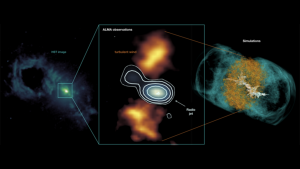Researchers have discovered that the Teacup galaxy is the ideal case to study the effects of relativistic jets on star formation.
An international team of researchers has discovered that the Teacup galaxy is the ideal case to study the effects of radio jets on star formation. The Teacup is a radio-quiet quasar located 1.3 billion light-years from Earth, gaining its nickname from expanding bubbles seen in optical and radio images. The central region of the galaxy also harbours a compact and young radio jet that has a small inclination relative to the galaxy disk. From studying the area, the team found that even in the case of radio-quiet galaxies, jets can impact a galaxy’s ability to form new stars.
The study, ‘Jet-induced molecular gas excitation and turbulence in the Teacup,’ is published in the journal Astronomy and Astrophysics.
How do jets impact star formation?
Huge amounts of active galactic nuclei are unleashed when matter falls into supermassive black holes in the centres of galaxies. Some of this energy is released when jets that are detectable in radio wavelengths travel at velocities close to the speed of light. When the jet travels across the galaxy, it collides with the clouds and gas around it and may push this material away in the form of winds. However, the preferential conditions for these winds to blow out the gas from galaxies are currently poorly understood.
Jets play an important role in how galaxies evolve in the Universe, impacting the content of galaxies such as star formation. The most powerful radio jets, hosted in ‘radio-loud’ galaxies, are responsible for drastically changing the fate of galaxies because they heat the gas, preventing new star formation and galaxy growth.

Computer simulations of relativistic jets project that jets change the shape of surrounding gas as they blow bubbles whilst piercing further into the galaxy. The simulations show that the factor which allows the jets to efficiently drive winds is the angle between the gaseous disk and the jet’s direction of propagation.
The team found that the compact jet accelerates the distribution of gas in a galaxy
The team used observations performed in the Chilean desert with the Atacama Large Millimetre/submillimetre Array (ALMA) to characterise the cold, dense gas in the central part of the Teacup. Specifically, they detected the emission of carbon monoxide molecules that can only exist under certain conditions of density and temperature. Based on these observations, the team discovered that although the compact jet has low power, it not only disrupts the distribution of the gas and heats it but also accelerates it in an unusual way.
It was expected that extreme conditions in the impacted regions along the jet would be detected, however, when the team analysed the observations, they found that the cold gas is more turbulent and warmer in the directions perpendicular to the jet propagation.
IAC researcher Anelise Audibert explained: “This is caused by the shocks induced by the jet-driven bubble, which heats up and blows the gas in its lateral expansion.
“Supported by the comparison with computer simulations, we believe that the orientation between the cold gas disk and the jet is a crucial factor in efficiently driving these lateral winds.”
Cristina Ramos Almeida, an IAC researcher and co-author of the study, stated: “It was previously believed that low-power jets had a negligible impact on the galaxy, but works like ours show that, even in the case of radio-quiet galaxies, jets can redistribute and disrupt the surrounding gas, and this will have an impact on star formation.”
The team will observe a larger sample of radio-quiet quasars in the future
The team will use MEGARA, an instrument installed on the Gran Telescopio CANARIA, to observe a larger sample of radio-quiet quasars. These observations will help the team understand the impact of the jets on the more tenuous and hot gas, and to measure changes in star formation caused by winds.









